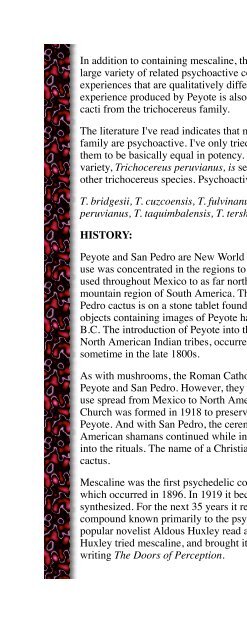DM Turner- The Esseential psychedelic guide
You also want an ePaper? Increase the reach of your titles
YUMPU automatically turns print PDFs into web optimized ePapers that Google loves.
In addition to containing mescaline, the cacti mentioned above contain a<br />
large variety of related psychoactive compounds, and will produce<br />
experiences that are qualitatively different than pure mescaline. <strong>The</strong><br />
experience produced by Peyote is also quite distinct from that produced by<br />
cacti from the trichocereus family.<br />
<strong>The</strong> literature I've read indicates that many members of the trichocereus<br />
family are psychoactive. I've only tried three or four of these and found<br />
them to be basically equal in potency. Many references indicate that one<br />
variety, Trichocereus peruvianus, is several times as potent by weight as the<br />
other trichocereus species. Psychoactive species include:<br />
T. bridgesii, T. cuzcoensis, T. fulvinanus, T. macrogonus, T. pachanoi, T.<br />
peruvianus, T. taquimbalensis, T. tersheckii, T. validus, T. werdermannius.<br />
HISTORY:<br />
Peyote and San Pedro are New World <strong>psychedelic</strong>s. In ancient times their<br />
use was concentrated in the regions to which they are native. Peyote was<br />
used throughout Mexico to as far north as Texas, San Pedro in the Andes<br />
mountain region of South America. <strong>The</strong> earliest known depiction of San<br />
Pedro cactus is on a stone tablet found in Peru dating to 1300 B.C. Ritual<br />
objects containing images of Peyote have been found dating back to 500<br />
B.C. <strong>The</strong> introduction of Peyote into the U.S. and Canada, and its use by<br />
North American Indian tribes, occurred much more recently, beginning<br />
sometime in the late 1800s.<br />
As with mushrooms, the Roman Catholic church tried to abolish the use of<br />
Peyote and San Pedro. However, they were only partially successful. Peyote<br />
use spread from Mexico to North America, and the Native American<br />
Church was formed in 1918 to preserve Native Americans' right to use<br />
Peyote. And with San Pedro, the ceremony practiced by many South<br />
American shamans continued while incorporating several Christian symbols<br />
into the rituals. <strong>The</strong> name of a Christian saint was even adopted for the<br />
cactus.<br />
Mescaline was the first <strong>psychedelic</strong> compound to be extracted and isolated,<br />
which occurred in 1896. In 1919 it became the first <strong>psychedelic</strong> to be<br />
synthesized. For the next 35 years it remained a somewhat obscure<br />
compound known primarily to the psychiatric community. In 1953 the<br />
popular novelist Aldous Huxley read about mescaline. Soon thereafter<br />
Huxley tried mescaline, and brought it to the attention of the public by<br />
writing <strong>The</strong> Doors of Perception.



